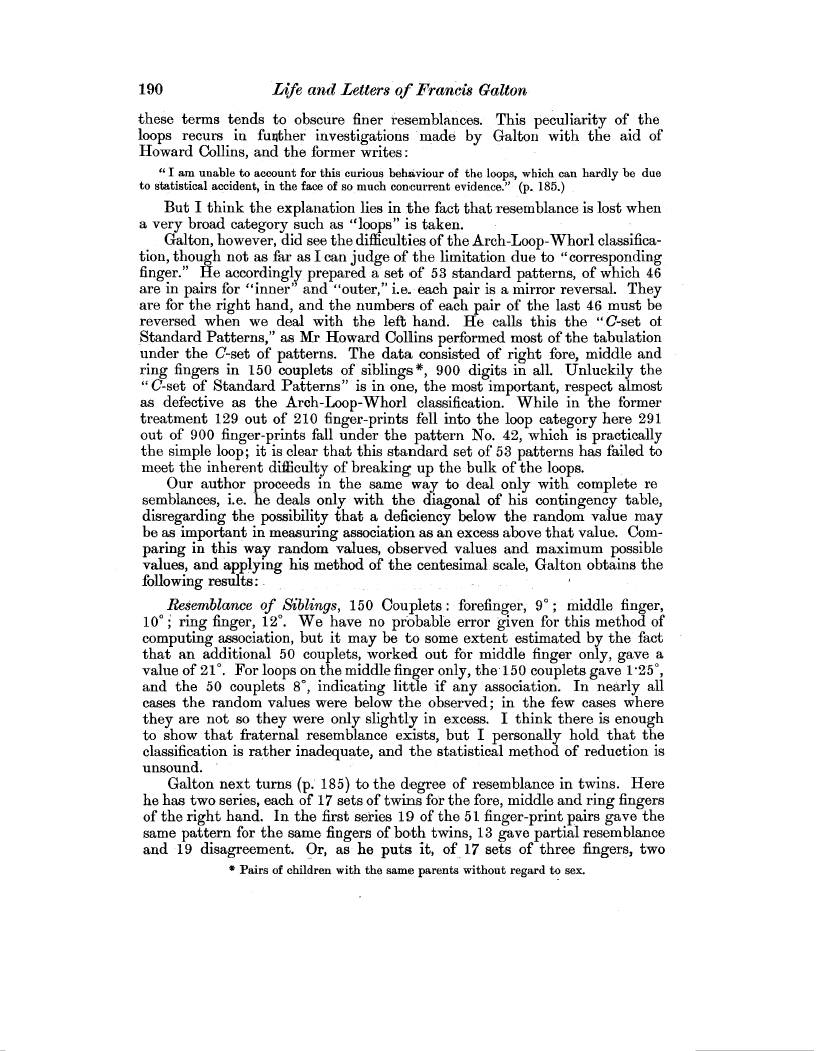| ||||||

OCR Rendition - approximate
190 Life and Letters of Francis Galton these terms tends to obscure finer resemblances. This peculiarity of the loops recurs in further investigations made by Gallon with the aid of Howard Collins, and the former writes " I am unable to account for this curious behaviour of the loops, which can hardly be due to statistical accident, in the face of so much concurrent evidence." (p. 185.) But I think the explanation lies in the fact that resemblance is lost when a very broad category such as "loops" is taken. Galton, however, did see the difficulties of the Arch-Loop-Whorl classification, though not as far as I can judge of the limitation due to "corresponding finger." He accordingly prepared a set of 53 standard patterns, of which 46 are in pairs for "inner" and "outer," i.e. each pair is a mirror reversal. They are for the right hand, and the numbers of each pair of the last 46 must be reversed when we deal with the left hand. He calls this the " C--set of Standard Patterns," as Mr Howard Collins performed most of the tabulation under the C-set of patterns. The data consisted of right fore, middle and ring fingers in 150 couplets of siblings*, 900 digits in all. Unluckily the " C-set of Standard Patterns" is in one, the most important, respect almost as defective as the Arch-Loop-Whorl classification. While in the former treatment 129 out of 210 finger-prints fell into the loop category here 291 out of 900 finger-prints fall under the pattern No. 42, which is practically the simple loop; it is clear that this standard set of 53 patterns has failed to meet the inherent difficulty of breaking up the bulk of the loops. Our author proceeds in the same way to deal only with complete re semblances, i.e. he deals only with the diagonal of his contingency table, disregarding the possibility that a deficiency below the random value may be as important in measuring association as an excess above that value. Comparing in this way random values, observed values and maximum possible values, and applying his method of the centesimal scale, Galton obtains the following results : . Resemblance of Siblings, 150 Couplets : forefinger, 9'; middle finger, 10';4 ring finger, 12°. We have no probable error given for this method of computing association, but it may be to some extent estimated by the fact that an additional 50 couplets, worked out for middle finger only, gave a value of 21°. For loops on the middle finger only, the 150 couplets gave 1.25°, and the 50 couplets 8°, indicating little if any association. In nearly all cases the random values were below the observed; in the few cases where they are not so they were only slightly in excess. I think there is enough to show that fraternal resemblance exists, but I personally hold that the classification is rather inadequate, and the statistical method of reduction is unsound. Galton next turns (p. 185) to the degree of resemblance in twins. Here he has two series, each of 17 sets of twins for the fore, middle and ring fingers of the right hand. In the first series 19 of the 51 finger-print pairs gave the same pattern for the same fingers of both twins, 13 gave partial resemblance and 19 disagreement. Or, as he puts it, of 17 sets of three fingers, two Pairs of children with the same parents without regard to sex.
|